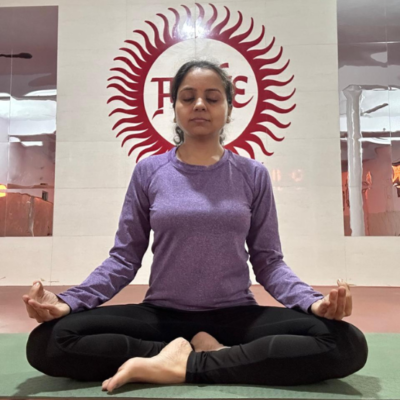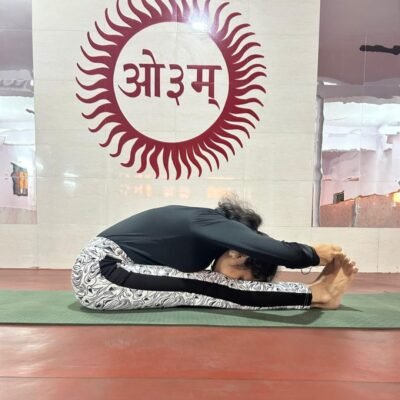Yoga for Urine Problems: A Holistic Approach to Managing Leaks, Retention, and Incontinence
- Home
- Medical Yoga Therapy
- Blog Detail
Urinary problems, ranging from leakage and incontinence to retention and blockage, are common issues that affect both men and women across different ages. While they may be caused by a variety of medical conditions, lifestyle habits, or even natural aging processes, they can often have a profound impact on an individual’s quality of life. Many people experience embarrassment, discomfort, and frustration due to these conditions, but what if there was a natural, non-invasive way to manage them?
Yoga, an ancient practice rooted in holistic health, offers powerful benefits for those suffering from urinary issues. It is well-known for its ability to improve flexibility, strength, and mental clarity, but fewer people are aware of its effectiveness in addressing urinary problems. Through specific asanas (yoga postures), pranayama (breathing exercises), and mindfulness techniques, yoga can help strengthen the pelvic floor, improve bladder control, reduce stress, and promote overall wellness.
In this article, we will explore the various types of urinary issues, how yoga can help address them, and which specific practices are most beneficial for managing problems like incontinence, urinary retention, leakage, and blockage.
Table of Contents
ToggleCommon Urinary Problems
Urinary Incontinence
Urinary incontinence, the involuntary leakage of urine, often results from weakened pelvic floor muscles or nerve damage and is particularly common among women after childbirth or during menopause, though it can also affect men as they age. There are different types, including stress incontinence (leakage during sneezing, coughing, or exercising), urge incontinence (a sudden, intense need to urinate), and mixed incontinence (a combination of both).
Research from Stanford Medicine and the University of California San Francisco found that 12 weeks of yoga reduced daily episodes of urinary incontinence in older women by 65%. Women who practiced stretching and strengthening exercises experienced similar benefits, with the effects of yoga and physical conditioning proving comparable to medications used to treat incontinence. These findings highlight yoga as a low-risk, cost-effective way to manage this common condition.
Urinary Retention
Urinary retention refers to the inability to completely empty the bladder. It can lead to discomfort, frequent urination, and urinary tract infections. This condition may occur due to blockages in the urinary tract, weakened bladder muscles, or neurological problems that affect bladder function.
Urinary Blockage
A blockage in the urinary tract can occur due to various causes, such as kidney stones, enlarged prostate (in men), or scarring of the urethra. This blockage prevents normal urine flow and can lead to painful and frequent urination, discomfort, and, in severe cases, kidney damage.
Leakage and Dribbling
Urinary leakage and dribbling are conditions where small amounts of urine leak out unintentionally. This is often due to weak pelvic floor muscles or damage to the nerves that control the bladder. It can happen during physical activities or even when a person is not exerting pressure on their bladder.
How Yoga Can Help
Yoga’s approach to health is holistic and deeply rooted in the mind-body connection. By focusing on the breath, body alignment, and strengthening key areas like the pelvic floor, yoga helps improve the overall functioning of the urinary system. The practice can help address the underlying causes of urinary issues, such as muscle weakness, stress, and poor posture.
1. Strengthening the Pelvic Floor
The pelvic floor muscles play a crucial role in bladder control. When these muscles become weak or overstretched, they can no longer support the bladder effectively, leading to incontinence, leakage, and even urinary retention. Yoga poses that specifically target the pelvic floor can strengthen these muscles and help improve bladder control.
Recommended Asanas for Pelvic Floor Strengthening
- Mula Bandha (Root Lock): Mula Bandha is a practice of contracting and lifting the pelvic floor muscles. This technique helps activate and strengthen the muscles that support the bladder and other pelvic organs.
- Bridge Pose (Setu Bandhasana): This pose works to strengthen the glutes, hips, and pelvic floor muscles. Lifting the pelvis off the ground while engaging the core and pelvic floor muscles helps improve circulation to the pelvic region and strengthens key muscles.
- Malasana (Garland Pose): A deep squat that encourages flexibility and strength in the pelvic area. This pose helps to tone the pelvic floor and stretch the groin muscles, which can improve bladder function.
- Child’s Pose (Balasana): While it may seem like a gentle pose, Child’s Pose helps release tension in the pelvic region and relieves pressure on the bladder. It also offers a calming effect on the nervous system, reducing stress-related urinary issues.
2. Improving Bladder Control:
In addition to strengthening the pelvic floor, yoga can also help improve bladder control by promoting better posture, increasing awareness of bodily sensations, and managing stress. Mindfulness techniques, such as focusing on the breath and being aware of the body, can help individuals become more attuned to their bladder and respond to urges more effectively.
Recommended Asanas for Bladder Control
- Viparita Karani (Legs Up the Wall Pose): This inversion pose helps regulate the nervous system, encouraging relaxation and reducing stress, which can exacerbate bladder problems. It also improves circulation to the pelvic area and supports urinary flow.
- Supine Spinal Twist (Supta Matsyendrasana): This twisting pose helps release tension in the lower back and abdominal muscles, which can relieve pressure on the bladder and improve overall bladder function.
- Cobra Pose (Bhujangasana): A backbend that opens up the lower abdomen and stimulates the bladder. It helps improve posture, which in turn can reduce the likelihood of urinary retention and leakage.
3. Reducing Stress and Anxiety

Stress and anxiety can contribute to urinary issues, especially incontinence. The body’s stress response can lead to muscle tension and overactive bladder symptoms. Yoga is known for its stress-relieving properties, making it an ideal practice for people with urinary problems related to anxiety.
Recommended Techniques for Stress Reduction
- Pranayama (Breathing Exercises): Techniques such as Nadi Shodhana (alternate nostril breathing), Ujjayi (victorious breath), and Kapalbhati (breath of fire) can calm the nervous system and reduce stress. These exercises promote relaxation, lower blood pressure, and support better bladder control.
- Meditation and Mindfulness: Incorporating mindfulness into a yoga practice helps reduce stress and improve mental clarity. Practices like body scan meditations and guided visualization can help individuals become more aware of their bodily sensations, including bladder urges, which can prevent accidents and improve urinary control.
4. Supporting Urinary Retention and Blockage
Urinary retention and blockage are often caused by issues such as an enlarged prostate (in men), muscle weakness, or nerve damage. Yoga poses that encourage proper posture, improve circulation, and reduce pressure on the bladder can aid in relieving the symptoms of urinary retention and blockage.
Recommended Asanas for Urinary Retention and Blockage
- Downward Dog (Adho Mukha Svanasana): This inversion pose improves circulation to the pelvis and relieves pressure on the bladder. It also stretches the spine and releases tension in the lower back, which may help with urinary retention.
- Bow Pose (Dhanurasana): This backbend opens up the abdomen, improving the function of the digestive and urinary systems. It also stimulates the prostate gland, which may help relieve symptoms of retention and blockage in men.
- Pigeon Pose (Eka Pada Rajakapotasana): This hip opener stretches and strengthens the pelvic muscles, promoting healthy circulation and reducing tension in the groin area. It can also aid in reducing discomfort from urinary blockage or retention.
5. Yoga for Men and Women: Special Considerations
For Women: Women are more prone to urinary issues like incontinence due to factors such as pregnancy, childbirth, menopause, and hormonal changes. Yoga can be particularly effective in addressing these concerns by focusing on strengthening the pelvic floor, reducing stress, and promoting relaxation.
Additional Asanas for Women:
- Kegel Exercises: Though not technically a yoga posture, Kegel exercises are a vital part of pelvic floor strengthening and can be practiced alongside yoga. These exercises involve contracting and relaxing the pelvic floor muscles to improve bladder control.
- Triangle Pose (Trikonasana): A standing pose that opens up the hips and strengthens the core muscles. This can help improve pelvic floor strength and bladder control.
For Men: Men may experience urinary problems due to conditions like an enlarged prostate or pelvic floor muscle weakness. Yoga can help by improving flexibility, circulation, and strength in the pelvic area, which supports bladder function and reduces the risk of urinary retention and blockage.
Additional Asanas for Men
- Seated Forward Bend (Paschimottanasana): This pose stretches the hamstrings and lower back, helping relieve tension and pressure on the bladder and prostate.
- Leg Raises: While not a traditional yoga pose, leg raises can be incorporated into a yoga practice to strengthen the lower abdominal and pelvic muscles.

Conclusion
Urinary problems, whether it’s leakage, retention, incontinence, or blockage, can greatly impact a person’s physical and emotional well-being. Yoga offers a comprehensive and holistic approach to managing these issues by strengthening the pelvic floor, improving posture, reducing stress, and promoting relaxation. With consistent practice, yoga can help individuals regain control over their urinary health and live a more comfortable, confident life.
If you’re struggling with urinary issues, consider incorporating a yoga routine into your daily practice. Always consult with a healthcare provider before starting any new exercise program, especially if you have underlying medical conditions. At Yoga With Barkha, we offer tailored yoga sessions that focus on improving pelvic health, strengthening core muscles, and supporting overall wellness. Whether you’re dealing with urinary leakage, retention, or other bladder issues, yoga may be the gentle, effective solution you’re looking for.
Share this


About Us
Quick Links
Contact Info
- B-69, Arya Samaj Mandir, Sector - 33, Noida, Uttar Pradesh 201301
- +91-8800094560
- yogawithbarkha.27@gmail.com
